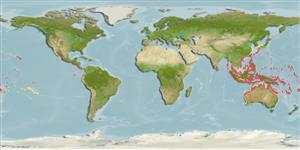Gastropoda |
Ellobiida |
Ellobiidae
Environment: milieu / climate zone / ระดับความลึก / distribution range
นิเวศวิทยา
. Tropical
Indo-Pacific.
Length at first maturity / ขนาด / Weight / Age
วัยเจริญพันธุ์: Lm ? range ? - ? cm Max length : 3.5 cm SHL เพศผู้/กระเทย; (อ้างอิง 349); common length : 3.0 cm SHL เพศผู้/กระเทย; (อ้างอิง 349)
Common on coastal environments, especially near forests (Ref. 349).
Life cycle and mating behavior
วัยเจริญพันธุ์ | การสืบพันธุ์ | การวางไข่ | Eggs | ความดกของไข่ | Larvae
Simultaneous hermaphrodites (Ref. 833). Development: single eggs into oval capsules of 0.2 mm length, which are interconnected by chalazae to form a more or less spiral chain; the capsules are contained in a sac-like gelatinous mass of 1 mm length; the gastrula stage is reached after 3-4 days of development; two days later the initial shell cap has been secreted, which subsequently increases rapidly in size; the velum shows a single disc-like lobe, which, however, exhibits two ciliary rings foreshadowing the bilobed condition of the newly hatched veliger; the foot has secreted an operculum and holds two statoliths within the corresponding cysts; during the eighth day of the embryogeny shell and operculum become functional to house the embryo and seal the aperture respectively; three days later veligers hatch out, which have no eyes, no mantle cavity and only the anlage of a heart (Ref. 99946).
Poutiers, J.M. 1998 Gastropods. p. 363-648. In Carpenter, K. E. and V. H. Niem. 1998. FAO species identification guide for fishery purposes. The living marine resources of the Western Central Pacific. Volume 1. Seaweeds, corals, bivalves, and gastropods. Rome, FAO. (อ้างอิง 349)
IUCN Red List Status
(อ้างอิง 130435: Version 2025-1)
CITES status (อ้างอิง 108899)
Not Evaluated
CMS (อ้างอิง 116361)
Not Evaluated
Threat to humans
Human uses
| FishSource |
เครื่องมือ
ข้อมูลเพิ่มเติม
นิเวศวิทยาเขตร้อนFood items (preys)
องค์ประอบของอาหาร
การบริโภคอาหาร
ผู้ล่า
Population dynamicsการเจริญเติบโตMax. ages / sizesLength-weight rel.Length-length rel.Length-frequenciesMass conversionอุดมสมบรูณ์ Human RelatedStamps, coins, misc.
แหล่งที่มาจากอินเตอร์เน็ต
Estimates based on models
Preferred temperature
(Ref.
115969): 25.4 - 29.3, mean 28.5 (based on 1590 cells).
Fishing Vulnerability
Low vulnerability (10 of 100).
Price category
Unknown.
